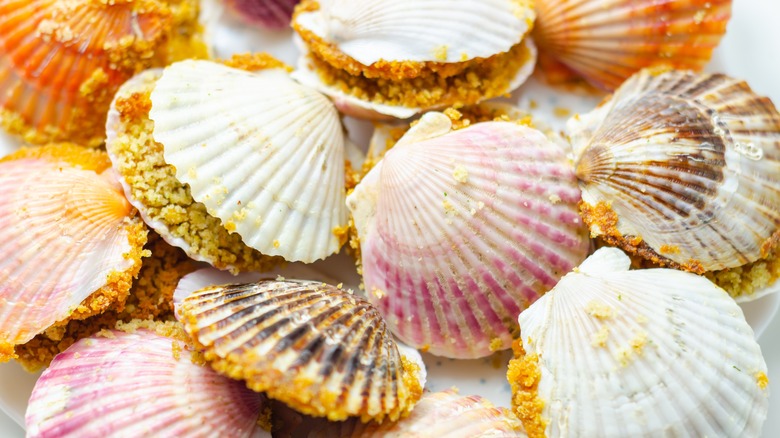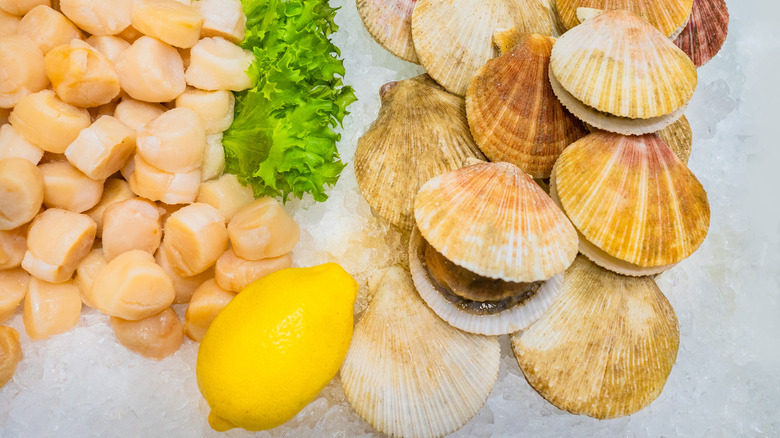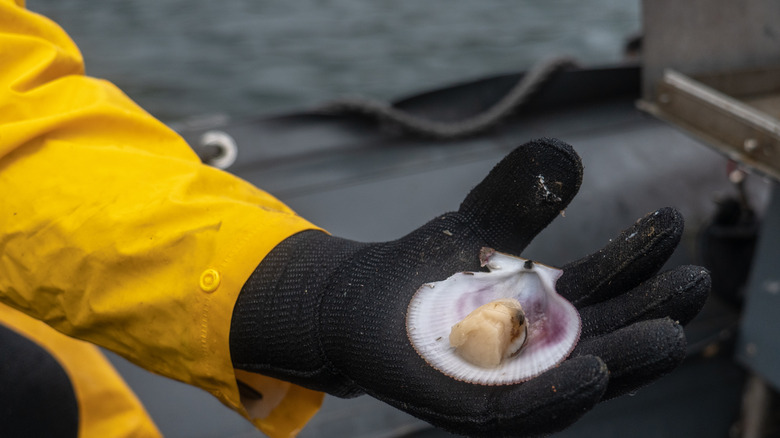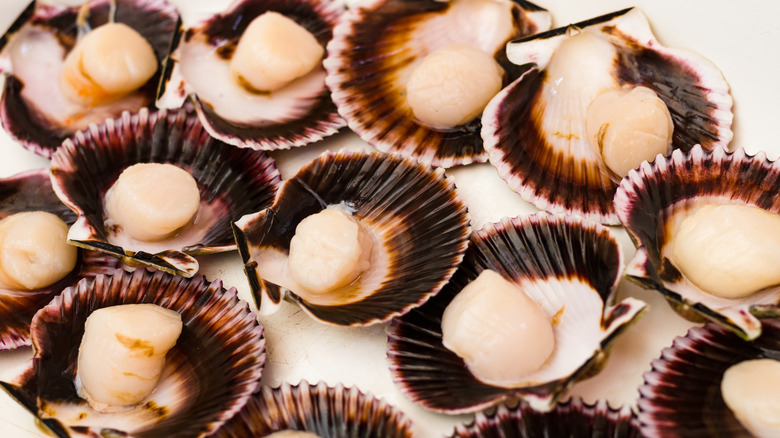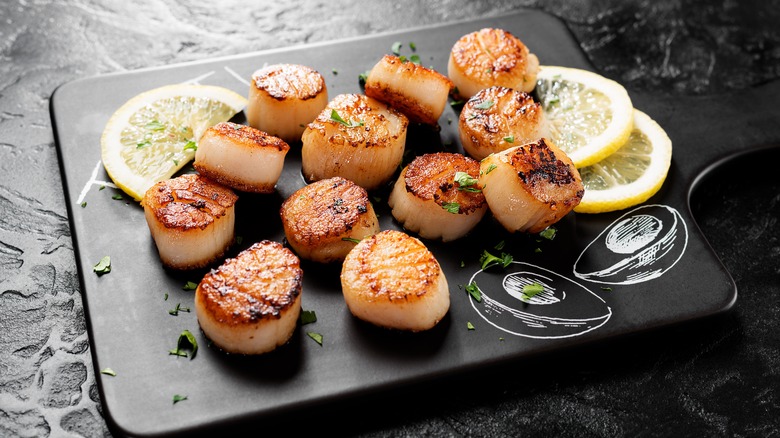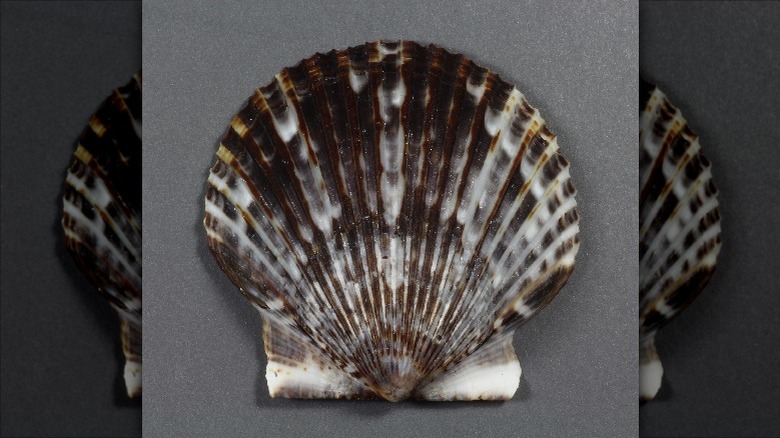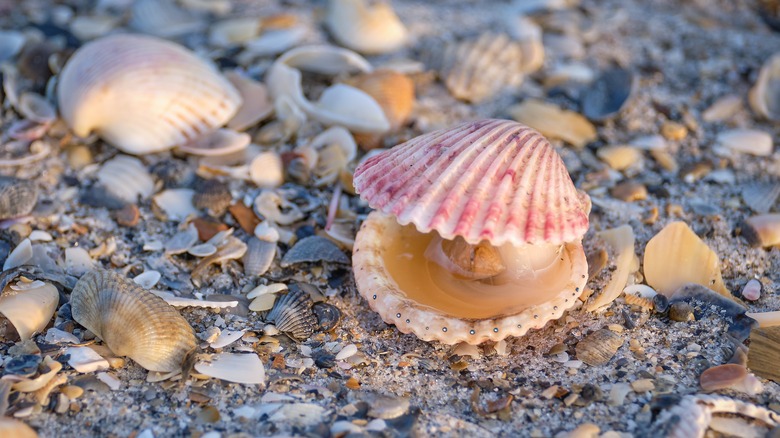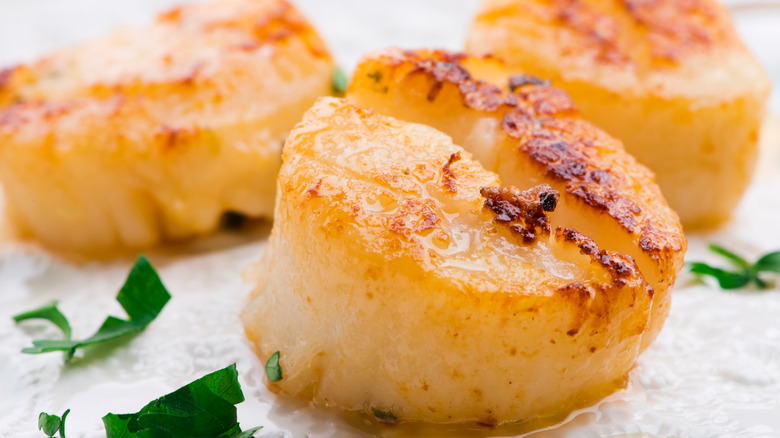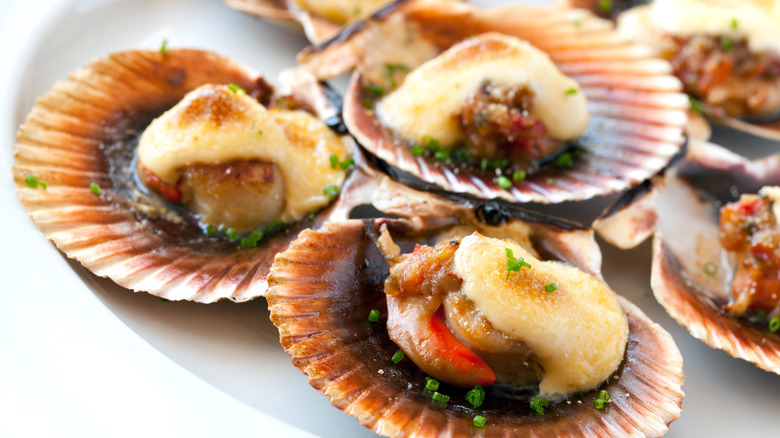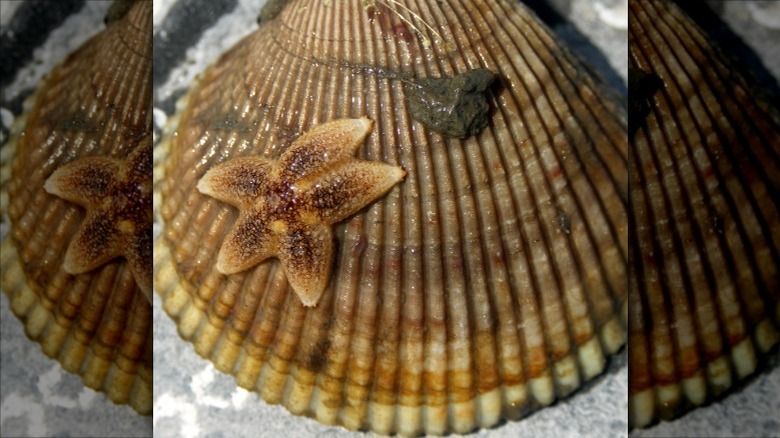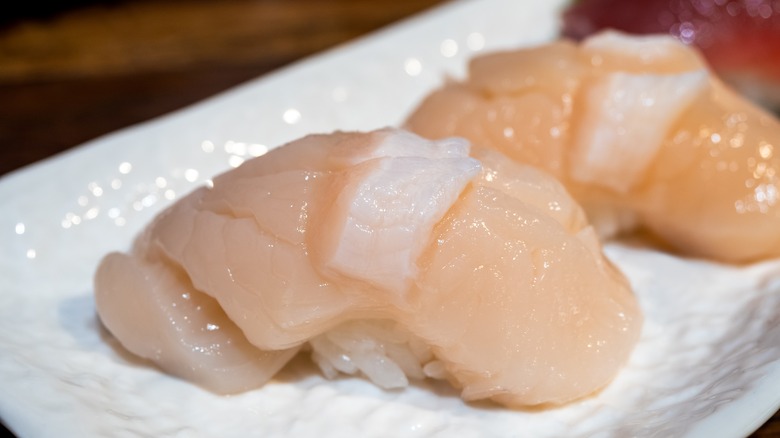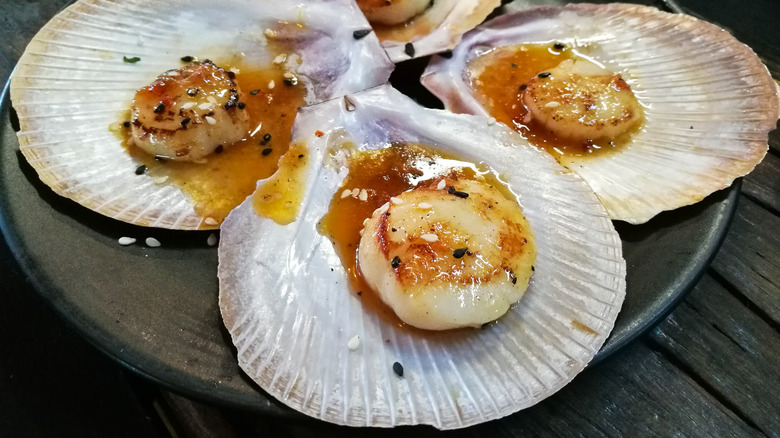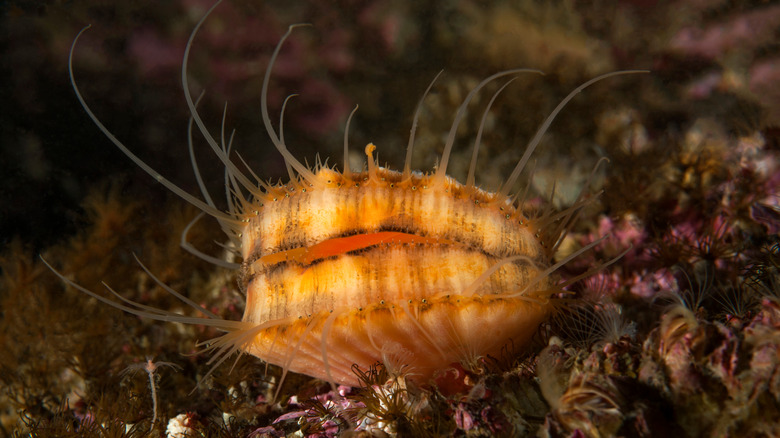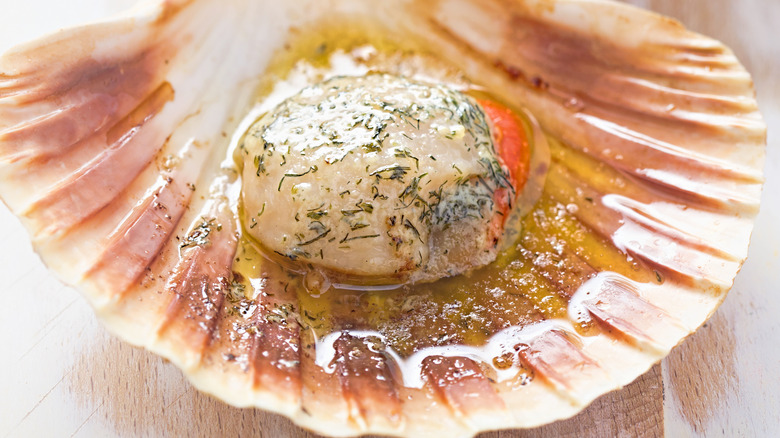The Ultimate Guide To Different Scallop Varieties
Scallops are among the most coveted sea creatures in the culinary world, prized for their sweet flavor and succulent texture. They are also extremely versatile, enjoyed both raw and cooked in a multitude of ways. They can be grilled, seared, baked, roasted, breaded and fried, baked into savory pies, or eaten right out of their shells. Scallops are excellent in sushi, sashimi, and ceviche preparations, putting their creamy texture and rich taste front and center with minimal enhancements. They can also take on more intense flavors and hold their own in recipes like Coquille St. Jacques, a classic French scallop dish that showcases the mollusk's opulence with the equally rich additions of wine, butter, and cream.
When diving into the world of scallops, though, it's important to understand that not all scallops are the same. There are countless varieties of these bivalves found in nearly every sea and ocean across the globe. They vary significantly in size, shape, and flavor and so are best suited for different purposes. There are other factors to take into account as well, such as how the scallops are caught, their freshness, and their treatment after they are harvested from the sea. Whenever possible, you always want to opt for fresh and local. We've got you covered here with an overview of this delicious seafood treat, a guide to the major scallop varieties, and how best to enjoy them.
The two basic types: bay scallops and sea scallops
There are two main types of scallops: bay and sea. As their names suggest, bay scallops are found in waters closer to shore, while sea scallops live farther from the coast in the open ocean. Both sea and bay scallops share the same basic traits: They are bivalve mollusks, which means they have two shells that are hinged and joined together by an interior muscle. Unlike other bivalve mollusks like oysters and clams, scallops can use their adductor muscle for propulsion through the water. This muscle is the most prized edible part of the creature.
One major difference between the bay and sea scallop is size. While size can vary within each group, bay scallops are much smaller than sea scallops, generally speaking. This makes bay and sea scallops suited to different preparations and cooking techniques. Bay scallops' smaller size means they're quicker to cook. Sea scallops take longer and have a larger surface area that is best prepared when grilled or seared in a pan to caramelize their edges.
The texture and taste of bay and sea scallops differ, as well. Bay scallops have a more supple consistency and a sweeter flavor, while sea scallops are meatier and tend to taste brinier.
Dayboat and diver scallops
You may see scallops labeled as dayboat or diver scallops. This doesn't refer to a particular species or variety but rather the methods that are used to harvest the scallops from the ocean. These labels can give you some idea of the quality of scallop you can expect.
Scallop season starts when the bivalves migrate toward the coast in winter, which allows fishing boats to head out, catch them, and return to shore in the same day – hence the name "dayboat." These boats capture scallops by trawling, or dragging a net along the sea bottom.
Diver scallops, as you may have guessed by the name, are harvested by people who dive down to the ocean floor and catch them by hand. True diver scallops are very rare and make up a miniscule amount of scallops caught every year – less than 1%. If you see the diver scallop label, you may want to approach it with a grain of salt, as many are only labeled as such to fetch a higher price and are not actually harvested by hand.
As long as you purchase carefully, in-season, and from a trustworthy vendor, diver scallops are the freshest and highest-quality scallops you can procure.
What's the difference between wet and dry scallops?
After scallops are harvested, they may go through a process in which they are introduced to a substance called STPP, or sodium tripolyphosphate. This step is meant to ensure they will stay moist even after being frozen. Once scallops have undergone soaking in this solution, they are known as wet scallops. Those that are not treated with STPP are known as dry scallops.
As it turns out, there is a major difference in quality between wet and dry scallops that affects them in many ways, from cost to cooking to taste. You get less for your money with a wet scallop, since the STPP solution adds water weight. An experiment by Cook's Illustrated found that wet scallops will also be more difficult to sear, as the extra moisture will leak out during cooking, wetting the pan and preventing proper browning. And despite this release of liquid, a fully cooked wet scallop still contains more water than a fully cooked dry scallop, resulting in an unpleasant texture and a duller flavor.
The choice is clear: Always opt for dry over wet scallops for the best quality. Check the ingredients list for packaged scallops and avoid buying them if it mentions STPP or added water. If they're not labeled and you're unsure, ask your vendor whether the scallops have been treated and specify that you prefer dry.
What are the different sizes of scallops?
Scallops vary greatly in size, from bay scallops that can be the width of a fingertip to meaty sea scallops the size of lemons. While they may be labeled with size descriptors like "small" or "jumbo," there's a more detailed scallop sizing system that will give you specific information and a better understanding of the dimensions of the scallops you're purchasing.
If you've shopped for scallops, you've probably come across the labels that consist of the letter U followed by a number or series of numbers. This is the size indicator. The number denotes how many scallops of that particular size make up a pound of weight. For example, it would take approximately 10 U10 scallops to reach a pound; this is one of the larger sizes out there. Scallops labeled U40/60, on the other hand, are four to six times smaller. Basically, the larger the number, the smaller the scallop.
Bigger does not necessarily denote better — the size of scallop you're seeking will vary based on preference and preparation method. But it's helpful to have a precise understanding of sizing so you know exactly what you're getting.
Atlantic bay scallop
The Atlantic bay scallop (Argopecten irradians) is found in its native habitat along the eastern American coast, from Massachusetts in the north to the Gulf of Mexico in the south. Full-grown shells range from approximately 2 to 3 inches wide, while the edible meat inside is much smaller. Petite and sweet, these bay scallops are treasured for their delicacy and flavor.
Sadly, the Atlantic bay scallop's population is in decline, due to changes to their habitat that have affected their food sources, including rising water temperatures, pollution, and other factors. Attempts have been made to create new habitats and restore existing ones for these imperiled scallops, with varying degrees of success. Promising populations found farther north in Nova Scotia and in farms in China may ensure that the Atlantic bay scallop can survive long into the future, much to the delight of fans of its tender, delectable meat.
These bay scallops are best enjoyed when their sweet flavor and pleasant texture are enhanced rather than overpowered. We recommend trying them raw or paired with citrus, like in this ceviche.
Calico scallop
The calico scallop (Argopecten gibbus) is similar in several ways to the Atlantic bay scallop, and, in fact, both types are closely genetically connected. However, calico scallops live farther south, most prominently along Florida's coastlines but as far south as Brazil. They are also found slightly deeper into the ocean than Atlantic bay scallops, which live closer to shore, although the waters they're found in are still relatively shallow.
Calico scallops get their name from the beautiful patterns found on their shells, often in the form of wavy lines or mottled spots that range in color from light pink to deep orange-brown. They're highly sought after for their decorative shells as well as their delicate, sweet-tasting meat. Typically smaller than Atlantic bay scallops, calico scallops can be prepared and enjoyed in much the same way as their close relatives, using a light touch to best complement their tender texture and subtle flavor.
Atlantic sea scallop
The Atlantic sea scallop (Placopecten magellanicus) is found in abundance along the northeastern American coast, from North Carolina in the south to Newfoundland, Canada, in the north. They're also sometimes known as deep sea scallops, giant scallops, or simply sea scallops.
Atlantic sea scallops are much larger than Atlantic bay scallops, with adult shells typically reaching around 6 inches in length. Compared to their bay scallop brethren, they also live in much deeper and colder waters. The scallops' bountiful fertility and up to 20-year life span certainly contribute to this species' plenitude, and thankfully so, as its meaty interior is prized for its fresh, briny flavor and toothsome yet tender texture.
Atlantic sea scallops are best prepared by taking advantage of their large surface area, which lends itself well to caramelization, creating a pleasing textural contrast to the soft interior. This can be achieved with grilling, broiling, or, most commonly, pan-searing the scallops until they're no longer translucent. Be careful not to overcook, or they can become tough and dried out.
Queen scallop
The queen scallop (known as both Chalmys opercularis and Aequipecten opercularis) is found in the Atlantic Ocean from Norway to Spain, as well as around the British Isles and the Mediterranean. These scallops are found in deep, cool waters, typically more than 300 feet below the surface. They tend to be smaller in size and live about half as long as Atlantic sea scallops, and their shells are brightly colored and decorative, similar to those of calico scallops.
The Isle of Man is particularly famous for its queen scallops, locally known as "queenies." The European Union graced these bivalves with PDO (Protected Designation of Origin) status in 2012. And in 2018, queenies were voted as the Isle of Man's official national dish. Sweet and buttery, queen scallops can be pan-seared like any other sea scallop, but they are particularly delicious when gently seasoned and roasted on the half shell.
Weathervane scallop
Weathervane scallops (Patinopecten caurinus), also known as Alaska scallops and giant Pacific sea scallops, can be found in the waters of the Gulf of Alaska and the Bering Sea, all the way down to the northern California coast. They're notable for being the largest scallops in the world, with shells regularly reaching at least 8 inches when fully grown.
Aside from their impressive size, weathervane scallops are prized for their high quality and intensely sweet, fresh flavor. Because they're so large, they can withstand a bit more cooking than other, smaller types of scallops. Even so, properly preparing weathervanes requires a gentle hand to avoid overwhelming their natural flavor or ruining their tender texture. As with all sea scallops, a simple pan sear is a great technique to use. Citrus and herbs will bring out weathervane scallops' natural bright, fresh quality, like in this recipe for scallops in dashi broth. Their size and richness can also handle deeper flavors like brown butter.
Japanese scallop
Known as Japanese scallops, Hokkaido scallops, or Yesso scallops (Mizuhopecten yessoensis), these beloved bivalves are native to the Pacific Ocean surrounding Japan. Japanese scallops are farmed in the areas around Hokkaido and Aomori, though they can be caught wild elsewhere. This species has also been cultivated in other parts of the world, including China and British Columbia, although it has more success in hatcheries with human intervention than it does surviving in natural conditions.
The soft, tender texture and creamy flavor of Japanese scallops make them well suited to raw preparations like sushi and sashimi. Nevertheless, like other sea scallops, they can also be enjoyed in cooked preparations; in fact, their versatility is one of the reasons they're so highly prized around the world. If you're enjoying a raw preparation of Japanese scallops, make sure you have a glass of Albarino handy as the perfect complementary wine pairing.
Tasmanian scallop
The Tasmanian scallop (Pecten fumatus) is, as its name suggests, found along the southern coast of Australia and the island of Tasmania. It's also known as the southern scallop or the commercial scallop. The scallops' shells tend to be pink-hued, and the meat inside is sweet and firm with a distinctive nutty taste.
Tasmanian scallops are both farmed and caught in the wild. As they are quite a popular species of scallop, farming has helped to meet the demand for these coveted bivalves. Boats and divers are used to capture them in the open water. Like other sea scallop species, Tasmanian scallops are versatile when it comes to cooking and are best enjoyed when their unique flavor and texture is allowed to shine without being overpowered by other ingredients. Tasmanian scallop pie is a popular local recipe, in which scallops are mixed with potatoes and other vegetables in a curry sauce and baked under a puff pastry crust.
Spiny scallop
There are two types of scallop that are caught in the waters of British Columbia and the Puget Sound: Chlamys rubida, known as the pink or Pacific pink scallop, and Chlamys hastata, or the spiny pink scallop. Both are also sometimes known as swimming scallops or singing scallops. These scallops are smaller than most sea scallop species, typically 2 to 3 inches in shell length. The colorful pink shells of these bivalves are often found covered by a sponge (as in the animal) that helps protect them from dangerous predators.
Thankfully, that leaves more for fishermen to catch. While small, the meat in pink and spiny scallops is intensely flavorful and is considered a rare delicacy. Try grilling them whole in the shell, with just a squeeze of lemon to accentuate their natural flavor. They can also be enjoyed raw or in any cooked scallop recipe, and their size makes them versatile in many preparations.
King scallop
The king scallop (Pecten maximus) is also known as the great Atlantic scallop, giant scallop, or, in France, Coquille St. Jacques. Its native habitat is in the eastern Atlantic Ocean, from Norway in the north to the Mediterranean in the south, and farther west to the Canary and Azores islands. As the name implies, they are a rather large species of scallop, though typically not as large as the weathervane scallop from the Pacific. Still, their size and quality make them highly desired among shellfish fans.
The king scallop is treasured for its substantial, firm meat and its silky texture as well as its mild, sweet flavor. It's delicious when prepared simply and elegantly but can also take on stronger flavors like garlic or bacon. The king scallop is so cherished in France that it has its own festival, the Fête de la Coquille Saint-Jacques, which takes place in Brittany every spring to celebrate the end of the scallop fishing season. It's a bucket list destination for any true scallop enthusiast.
Static Media owns and operates Daily Meal and Tasting Table.
